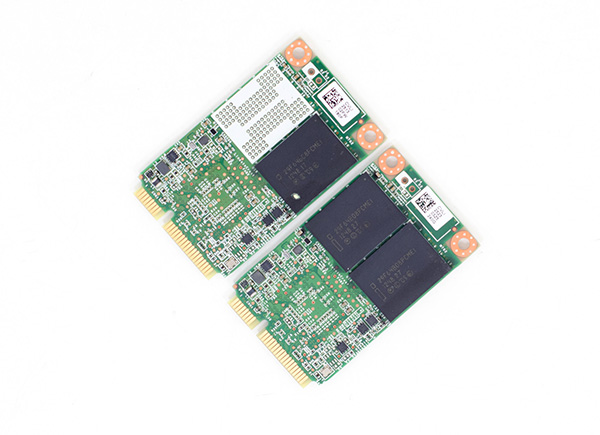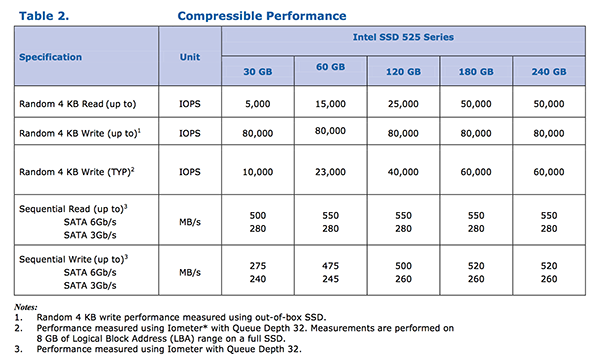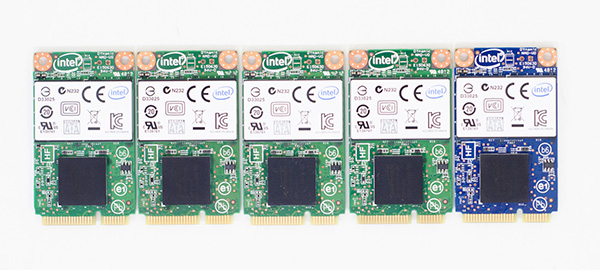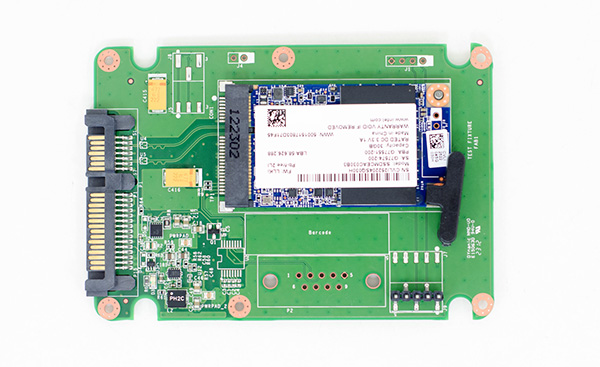The Full Intel SSD 525 Review: 30GB, 60GB, 120GB, 180GB & 240GB Tested
by Anand Lal Shimpi on February 3, 2013 2:30 AM EST- Posted in
- Storage
- SSDs
- Intel
- SandForce
- Intel SSD 520
- Intel SSD 525
Last week we published a teaser look at Intel's latest mSATA SSD: the Intel SSD 525. At the time we only presented performance for a single 240GB drive, however Intel decided to break the mold and send us nearly every capacity in the 525 lineup. We've finally completed testing of the remaining capacities and can now bring you a full look at the Intel SSD 525 lineup.
Typically manufacturers send along their best performing SSD and what follows after launch is a bunch of begging for or outright purchase of additional capacities in order to present the most complete picture. Intel was one of the first companies to send along both large and small capacity SSDs in for review, so it's no surprise that they're one of the first to send nearly every member of a new SSD family for review. I can't stress how important it is that other manufacturers follow in Intel's footsteps here. Given the direct relationship between the number of NAND die/packages on an SSD and the performance of the drive, being able to demonstrate the performance of the entire family is very important to those looking to make an actual buying decision.
In the case of the 525, Intel did a good job of keeping things pretty simple. Since the 525 is exclusively an mSATA drive, there's only room for a maximum of four NAND packages on board. The 525 still uses 25nm 2bpc MLC NAND, which is limited to 8GB of NAND per die and 8 die per package (64GB max per NAND package). This is where the 240GB max capacity comes from (256GB of actual NAND).
With the exception of the 90GB and 180GB drives, all of the 525s populate all four NAND packages. The 90GB and 180GB drives are the exception and only feature three NAND packages on board:

Intel SSD 525 180GB (top) vs. Intel SSD 525 240GB (bottom)
The full breakdown of capacities and NAND split are listed below:
| Intel SSD 525 | |||||||
| Advertised Capacity (GB) | User Addressable Space (GiB) | Total NAND On-board (GiB) | % Spare Area | NAND Packages Number/Die per Package/Package Capacity | MSRP | ||
| 30GB | 27.95 GiB | 32 GiB | 12.6% | 4 / 1 / 8 GiB | $54 | ||
| 60GB | 55.89 GiB | 64 GiB | 12.6% | 4 / 2 / 16 GiB | $104 | ||
| 90GB | 83.82 GiB | 96 GiB | 12.6% | 3 / 4 / 32 GiB | $129 | ||
| 120GB | 111.79 GiB | 128 GiB | 12.6% | 4 / 4 / 32 GiB | $149 | ||
| 180GB | 167.68 GiB | 192 GiB | 12.6% | 3 / 8 / 64 GiB | $214 | ||
| 240GB | 223.57 GiB | 256 GiB | 12.6% | 4 / 8 / 64 GiB | $279 | ||
All of the 525 members feature the same ~12.6% spare area (~14% OP). Despite the reduction in number of NAND packages, the 90 and 180GB models aren't actually any slower than the 60GB and 120GB versions respectively. The reason that performance doesn't suffer when going to these odd sizes is because Intel/SF do a good job of parallelizing requests across all NAND die within a package, of which there are physically more in the 90/180GB configurations compared to the 60/120GB models.

I went over the rest of the details of the 525 in the initial review. In short, the SF-2281 controller is still at use but paired with firmware that's directed/validated by Intel. Performance, compatibility and stability can be different on the 525 compared to other drives that use SandForce's SF-2281 controller. The 525 in particular uses a newer version of the Intel branch of the SF-2281 firmware with additional stability/compatibilty enhancements and power optimizations. The 525's LLKi firmware revision hasn't been backported to the 520/330/335 and as of now there aren't any public plans to do so. The 525 also comes with a 5-year warranty from Intel.

Performance of the 525 is very similar to the 2.5" Intel SSD 520 that came before it, the big difference here is the physical size of the drive as the 525 is mSATA only. For all testing we used an mSATA to SATA adapter:












26 Comments
View All Comments
Shadowmaster625 - Monday, February 4, 2013 - link
So intel is serious about ultrabooks? Their actions seem to prove otherwise.That SSD controller should be integrated into all their i-series cpus. Windows is slow and unwieldy in large part due to intel not providing an efficient nonvolatile storage platform. If every windows installation had guaranteed access to even a small amount of fast nonvolatile memory, then maybe we would see less cpu cycles wasted moving data around from HDD to RAM to another part of RAM and then back to HDD then back to RAM 50 million times.
FunBunny2 - Monday, February 4, 2013 - link
Here's what Linus said back in 2007:... but Flash-based storage has such a different performance profile from rotating media, that I suspect that it will end up having a large impact on filesystem design. Right now, most filesystems tend to be designed with the latencies of rotating media in mind.
melgross - Monday, February 4, 2013 - link
I don't understand why mSATA drives seem to cost more than regular drives. Most drives come in an aluminum case, which isn't cheap to make, plus the assembly that's then required. I would think that these, being just chips on a circuit board, without even the soldered on sockets a regular drive has, would be a good 10% less, not more.mcnabney - Monday, February 4, 2013 - link
Manufacturing cost frequently has little to do with MSRP.An obvious example of cheaper to produce media selling for more would be compact disks and DVDs versus their predecessors using magnetic tape. The digital media had a significant upcharge despite production costs being significantly lower.
DanNeely - Monday, February 4, 2013 - link
Probably lower sales volumes. Even if the total sales volumes (and marginal development cost per unit) are similar, relatively few consumers are buying mSata vs 2.5" models. This results in less competition between retailers to push margins down and higher expenses for the same (because of the longer time periods between when they buy and sell the devices that their purchase costs have to be covered by borrowing).melgross - Monday, February 4, 2013 - link
Manufacturers will be the main customers for these drives. But price also determines sales volume. Price them too high and volume drops. There couldn't have been too much extra R&D on these, as they are basically the same as drives inside a case. The small circuit boards cost little to design and manufacturer, and Intel is paying the same thing for the chips.RU482 - Monday, February 4, 2013 - link
good to see that newegg is off to some early profiteering with the 120GB version on sale at $169.99philipma1957 - Monday, February 4, 2013 - link
Simple make a mobo that runs them at sata III speeds. I have yet to find one.A small form itx with a 480gb crucial m500 running at full sata III would be a reason to buy a mSata.
I really quite a bit frustrated as this block to my build in the coolermaster elite 120 cases. the case allows
an i7 3770k
a full sized psu
a full sized bluray
a full sized hd7970
the better itx mobos have a msata slot that boots but they are sata II.
it is a real shame as this case allows for high over clock speeds with easy mods.
you can have an almost perfect one card machine with the msata ssd.
you can fit a 2.5 inch sata ssd so you can have a very powerful machine but a power wire a sata wire and the drive case itself do make the case more crowded.
Jaseemxx91 - Monday, February 4, 2013 - link
Can anybody tell me if this will fit inside my Ux31e Ultrabook?Anand have said that it has a different port than that of an Mac book Air here
www.anandtech.com/show/5854/asus-zenbook-ssd-and-apples-macbook-air-ssd-are-not-compatible
My Zenbook ssd is dead, and i dont know which one to get, that is compatible in my system.
Could somebody help me with this?
I would really love an Answer from Anand himself, as he has already seen and inspected the Connector himself. But as i am not So Lucky guy, i dont really think Anand would even read this :/
Btw, Congrats on this extremelY informative Site of yours. Keep up the Great Work. :)
Death666Angel - Monday, February 4, 2013 - link
Asus uses a proprietary connector as well, so any off the market mSATA drive will not work. Look for specific UX31 drives. Email ASUS, they should be able to provide you with information and maybe even a replacement (for free or for money). If you want to reach Anand directly, try Twitter. :)